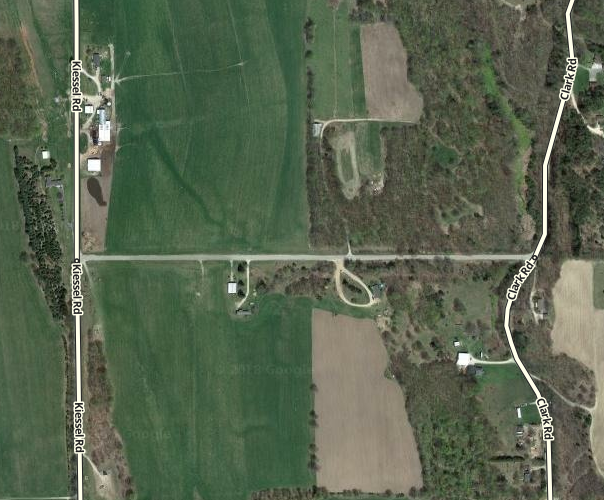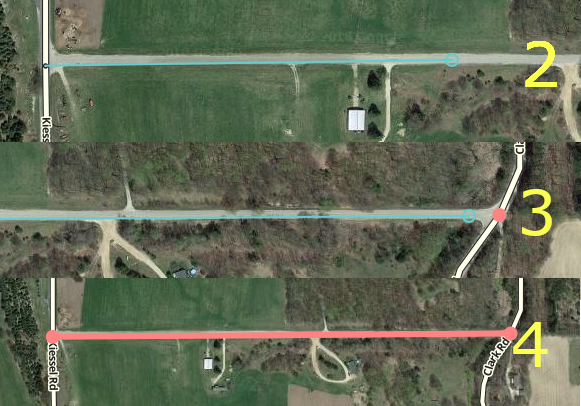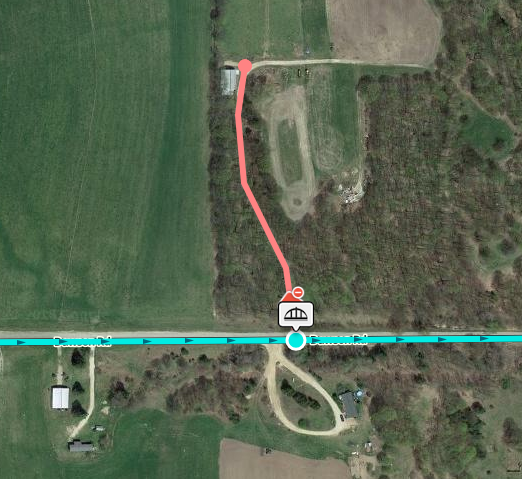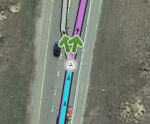This article covers creating and editing road segments. Be sure to read this whole article to ensure you fully understand all aspects of how segments operate in Waze before you start to create and edit roads on the map.
Creating a new road
If you find a road missing from the Waze map, such as a recent suburban development, follow the screenshots and instructions to add a road to Waze. The example is from Michigan, USA, and we will add the missing roads in the highlighted area:
Zoom the map display so you can see the entire area where you need to add the road, if possible. Setting the zoom level appropriately allows you to follow the curves of the road as you draw it.
There are five essential steps to add roads to the Waze map:
- Draw the road.
- Set or confirm the road properties.
- Connect the road with junctions to existing segment(s) or another newly created segment(s).
- Set allowed turns at junctions.
- Save the changes.
Drawing the road

Hover the cursor over the road menu at the top of the screen in the toolbar and click Road. You can also use the keyboard shortcut, which is the letter i, for Insert. Move the cursor to the location you want to start drawing the road. This can be an empty location, or it can be on an existing segment where you want the intersection with this new road. The cursor has a small blue circle to indicate it is in drawing mode.
When you hover over an existing segment, it highlights showing that if you click there, a junction is automatically added.
Move your mouse along the path of the road, following the aerial view or GPS points for the new road. Every time you click, a geometry node is added, aligning your new road with your cursor movement. When you reach the end location for the new road, double-click the mouse. You exit drawing mode, and the new road displays in red to signify that it is new / changed, but unsaved. Don't worry if you made a mistake in drawing the shape of the road. Just click on the segment again and you can add, remove, or reposition geometry nodes. If you want to remove the road while drawing, you can press the ESC key on the keyboard to exit drawing mode.
At this point, you can save the newly added road(s) if you wish. However, the process of properly adding the road(s) is not complete. All new roads are set as 1-way, with no associated city and street name. Adding these details to the road is required before they show up in the Waze client app.
Note: When creating special roads like roundabouts and loops, be sure to follow the special considerations for those roads in those linked sections.
Confirm the road by updating details
New road segments created via the app's Pave road function are not immediately displayed on the Waze app for other users. They must first have city and street names confirmed, meaning that an editor must add that information. The editor will also have to connect them to the road network to make them usable.
Red
Roads
In the map editor, roads are outlined in red when city and street name properties have not been set (known as red roads or unconfirmed roads). An editor should set the country; state (US only); city; street name; road type; and direction.
| Paved roads do not appear until being "touched" in the editor. This does not apply to roads created in the editor; when created in WME, roads can appear on the Waze app even if they are missing key properties. |
To confirm a road, select one or more segments with the mouse. You can add only one name at a time, but you can add it to multiple segments at the same time. Because of that, it is efficient to first select multiple segments that will share the same name, and then apply the name to them together. Notice below that for the first road there are now two one-way segments. This is because the second road we added has cut the original road into two segments.

To edit the address details of the selected segment(s), find the phrase No Address in the upper left corner of the editor in the Address input box. "Click" on the input box. Make sure the Country and State values are correct. Next, enter the city and street name information. Sometimes, a segment is outside a municipality, or the municipality cannot be determined or is not relevant. If that is the case, then choose None for the City. Similarly, some streets may not need a name, such as ramps, private roads, and parking lot roads. For those segments, choose None for the Street.
Most roundabouts also must not have a street name. Use None for them. This permits proper navigation instructions for the roundabout.

For segments that exist only to connect two one-way roads (At-grade connectors), do not name the segment. The city name is fine if the segment is clearly inside the city limits.
| When complete, click the Apply button. If you do not click the Apply button, your changes will be discarded by WME without warning when you save or click another object in the editor. Please click the Apply button as soon as you finish entering information, so you do not lose your data. |
Set Road Type, Direction, and Elevation
Set each of the fields Road Type, Direction, and Elevation. For neighborhood streets in these examples, Local Street (or Street depending on local area) is appropriate, they are 2-way streets and they have no roads above or below them, so elevation Ground is correct.
Review the article determining one-way streets for more information on directionality.
- Please be aware the the directionality type 'Unknown' does not prevent Waze from routing onto a road. 'Unknown' really means 'Undefined'. When the direction is set to 'Unknown', Waze automatically adjust the directionality of the road as Wazers drive it. This is the initial directionality of all roads after a base map import. In addition, locking the segment does not prevent the directionality from changing on 'Unknown' roads as Wazers drive it.
You may choose to save now, but there is one more step before the process is complete: setting the allowed turns.
Set allowed turns (connections)
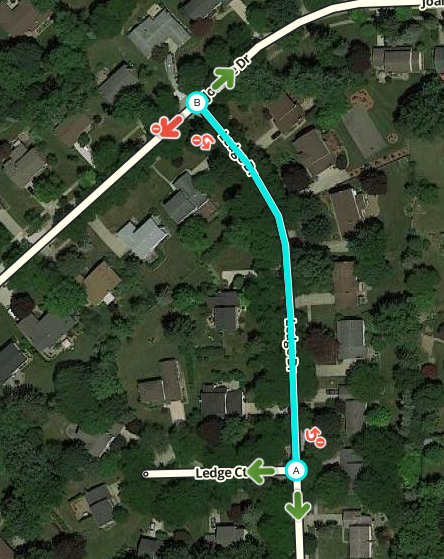
We've added our roads and confirmed them, but we haven't set the legal directions to and from this segment. In the real world, there are barriers and signs which prevent travel in a certain direction, even though the roads connect to each other. In our suburban neighborhood example, none of these blockages exist, but our screenshot shows red arrows, meaning that Waze generally won't navigate that direction from the selected segment. Click on the red arrows to turn them green, and permit navigation in that direction. This needs to be done for each segment that is added to the map, as the default setting after connecting a new segment is to disallow all turns to the new segment.
In situations where not all turns are allowed, click on the arrow to turn it red for the disallowed direction from that segment.

If all turns are allowed at a junction, the fastest way to enable all turns is by selecting the junction node and not the individual segments. Select the junction and it changes from a small black circle to a blue circle with a white border. Note that if you have already selected a segment connected to that junction, click elsewhere on the map, or hit the ESC key to deselect that segment before you can select the junction.
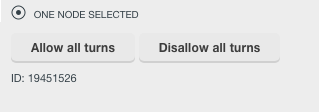
The left pane shows action links for the selected junction. Depending on the current state of the junction, one or both of the links Allow all turns or Disallow all turns links appear. For example, if all turns are currently allowed, then only the Disallow all turns link appears.
To enable all turns at an intersection, click the Allow all turns link for the junction. Alternatively, you can use the keyboard shortcut w to allow all turns and the shortcut q to disallow all connections. A best practice when allowing all turns on a junction is to disallow all turns first, as it cleans up some legacy problems with the map.
Other helpful turn arrow keyboard shortcuts are:
| a - Toggles between making the turn restriction arrows directly selectable (opaque) or transparent. Transparency enables selecting objects below the arrow on the map. |  |
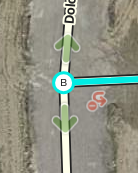 |
To see all keyboard shortcuts, press the ? on the keyboard.
When turns or parts of a road are restricted certain times of day or days of the week, you can use the scheduled restrictions feature.
As the roads connecting to each other usually allow for all turn connection / direction, it is saves a lot of time for the editor to enable “draw new roads with all turns allowed” under the left pane “settings” tab during editing process.
See the section turn restrictions for more information on all turn arrows.
Save
If you have saved your progress or not, click the Save button (or use the Ctrl + s keyboard shortcut (Command + S on Mac)) to send all of your updates to the Waze servers for processing. After the save is complete, and if there are no errors, you are presented with a view of the final product of this process:
It is a good practice to save your changes often, and certainly when you get more than 10 unsaved changes pending. Sometimes you may run into a save error that you cannot determine what is wrong, and you have to undo many prior edits or remove the edit causing the issue from the history log by hovering over the save button. Saving regularly limits chances of lost work in case of unresolvable errors.
Editing existing roads
Editing an existing road segment is not very different from creating a new road. Once a road is drawn from scratch, before it is saved, all of the editing functions described here work.
Adjusting road geometry (nodes)
Adjusting road geometry is changing the shape or appearance of a road segment. Real-world roads may be realigned, or mapped roads may be in the wrong place because the data from the basemap import was wrong. Sometimes we need to realign roads to improve navigation or spoken instructions in the Waze mobile app.
The instructions here, while written for an existing road segment, also apply to a new road segment you just created, but have not yet saved. The editor treats them the same.

To start adjusting the geometry of a segment, click on it. When you hover over the highlighted segment, geometry nodes (white circles outlined in blue) and inter-geometry nodes (light blue dots circled in darker blue) display along the segment. Both of these are draggable so that you can reposition them wherever you need. When you drag an inter-geometry nodes from its default position half-way between two geometry nodes, it turns into a geometry node.
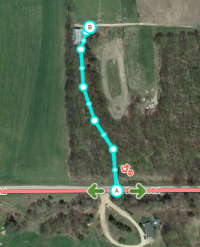
To delete a node, hover the cursor over a node and hit the d key on the keyboard. This only works with nodes, not inter-geometry nodes.
Tip: Straighten segments quickly If you have a segment that you need to clear all the geometry node quickly, select the segment and hold down the d key. Then move the mouse pointer near the geometry nodes you want to remove. With the d key held down it will automatically delete the node when the mouse hovers over it. To stop deleting nodes, stop pressing the d key.
When you have a long, straight stretch of road, and there are geometry nodes located along its length, delete these nodes, unless the node is there to change a speed limit. It simplifies the road segment if you have to adjust it later, lightens the load on the database, and makes it easier to display on the Waze client app.

When your moves are complete, save, and the segment appears in the map with the new geometry. To see these operations in action, you can watch a video of adjusting segment geometry.
Junctions
Before making any change to a junction, be sure to review the Junction Style Guide for information on the best practices for creating junctions. There are many times when a junction may be drawn in a way that does not seem logical, but it is very important to the navigation engine in Waze.
Moving junctions
Moving a junction is as simple as dragging the junction to another location, however there are geometry nodes (the white circles outlined in blue when editing the segment) that might need to be moved or removed.
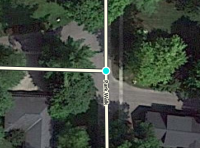
First use the mouse to select the intersection of the road segments. This puts a blue circle, outlined in white, on the junction. This indicates you are moving all the segment endpoints connected to this junction. Note that if the blue circle appears transparent, it means that one of the attached road segments is locked above your editing rank, and the junction cannot be moved by you. Release the mouse button and move the mouse slightly until the cursor appears as a 4-way crossed arrow ![]() .
.
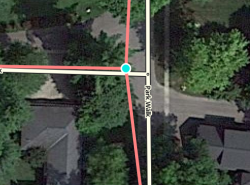
With the cursor as a crossed arrow, "click" the junction again and drag it to the desired location. The angles in the segments in this example are caused by the geometry node and need to be adjusted. It is important to position the junction in a location that is not on top of a segment. This makes it difficult to adjust the geometry nodes. (Optionally, you may "Click and Hold" when selecting the Junction Node to start moving it immediately.)
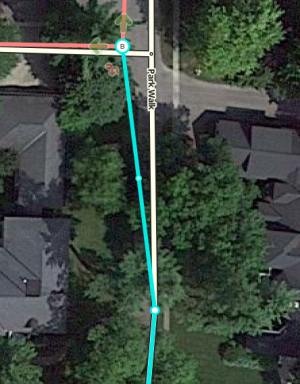
The white geometry nodes outlined in blue, can be moved, removed, or added as explained in detail above. Adjust them to align with the aerial views or the GPS tracks.
Moving one junction onto another junction
If two junctions are disconnected from each other, but should be joined into one junction, then dragging one of the junction nodes until it "snaps" to and connects to the other junction node will bring them together.
| Warning! Only use this technique if the two junctions are disconnected from each other. If there is a segment connecting the two, you could accidentally delete the segment in the process. This would also delete any traffic data and house numbers associated with the deleted segment. |
Removing junctions with only two segments
There are times when only two segments are joined at a junction. In general this is not a problem, but it can slow down editing and it may be the source of incorrect turn restrictions and bad routing. So the best practice is to delete these junctions when found. However, it is very important to study the two segments before merging, to ensure the junction is not there for a purpose.
| Legitimate Reasons for Two-segment Junctions |
|---|
|
Once you are certain there is no reason to have the extra junction, there are two methods to remove it. One method highlights the junction and deletes it and the second highlights the two segments and bridges them together.
Delete key or trash can icon
This method is the preferred method, because it enables the WME to alert you when there are legitimate differences between the segments. Using the mouse, select the junction node between the two segments. Look for the trash can icon at the upper right corner of the WME screen. If it appears press it to remove the junction. Alternatively, the Delete or Del (Fn + delete on Mac) key (not Backspace) removes the junction.
Deletion of a node automatically places a geometry node at that point. If you need to remove the node, you can do so by selecting the segment and hovering the mouse over the point of the prior junction. The WME will be displaying the node and you can press the d key to remove the nodes as mentioned earlier on this page.
| If the trash can icon does not appear, something about those two segments is different, possibly the city name, street name, road type, direction of travel, speed limit, etc. |
Bridge segments
 Generally do not use this method because it has two additional side effects that are not generally desired.
Generally do not use this method because it has two additional side effects that are not generally desired.
- It increases the elevation of the resulting single segment by one.
- It disconnects any other segments at that junction point, but leaves it directly below the geometry node potentially causing automated map problems if not moved.
With the mouse, select one of the segments. Then, while holding down the multi-select key (Control for Windows/Linux and Command for Mac) select the second segment. If the two segments have the same properties including direction, a small bridge icon appears above the junction. Click the bridge to merge and bridge the two segments, eliminating the junction between them. A geometry node is placed where the junction was previously located. To remove the node (if necessary), select the segment and hover the mouse near the old junction. The geometry node should be displayed. Then, press the d key to remove the unwanted node. When the segments are different, the bridge icon does not appear at the junction.
Cut a segment to create a new junction
If it is necessary to change road information in the middle of a segment (road name, direction, city, type, or other information changes at that point), you need to create a junction at that point. One way to do this is to create a new road connected to the previous road. Begin or end the new road on the previous road to create a new junction. Then delete the new road -- the junction remains, and the previous road segment has been cut at the point where you created and deleted the road.
Allow/Disallow connections
Changing the allowed and disallowed turns in a junction follows the same procedure for controlling them when updating a road segment described above.
(Re)Moving a road from a junction
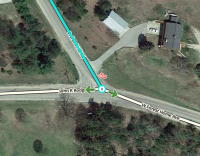
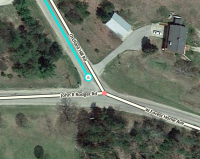
The need to remove a road segment from a junction node may arise at certain points (road blocked off by subdivision, fixing errors in the junction node, etc.). When removing a road from a junction, it must be noted that the traffic data for that road segment at the junction will be removed.
- Select the road you want to remove from the junction.
- Hover your mouse over the segment end node (on the junction) and you will see the black 4-point arrow for moving items appear.
- "Click and Hold" on the node and drag it off of the junction node.
- Save your edits for the changes to take affect in the WME.
Note: before saving changes, the junction node will be red in color and the segment modified will be highlighted in red.
Updating road details
The details of a road can be entered or updated using the same procedure outlined here.
To update details, first, select the segment(s) you need to update. Click on the segment and the segment turns blue.

Multiple segments may be selected by holding down the modifier key and clicking additional segments. The modifier key for Mac is the command key, for Windows the control key and for Linux the control key. Each selected segment turns blue.

Once selected, if the General tab is visible on the left side of the editor, you would see the following:
Address properties

At the top of the properties toolbox are the address fields. The address fields include the street name, city name, State (currently only in the United States) and country. To edit the address details, click the Edit button (or press the 'e' shortcut key). This enables editing of fields above it.
The Country (and State) fields may be updated by selecting a different country (or state) from the dropdown selections. Selections are provided only for countries (or states) that are present on other nearby road segments.
The city and street names may be updated by typing a new name. See the naming guidelines for guidance on choosing the correct street name. As a name is typed, Waze provides a list of similar names. These similar entries can be selected by clicking them. If the segment is in a location outside a city, "None" should be selected for the city name. If the road does not have a name, "None" should be selected for the street name. Entries must be present for each address property. To eliminate a city name or street name "None" must be entered. When complete, click the Apply button. If no changes are to be made, click the Cancel button.
If the above Address Properties are not set for a segment, the road displays as a red road . This process is part of the road verification process to indicate in WME that the road needs these properties added. See the section on confirming details for more information on red roads.
Alternate street names
The subsection Alternate street names: lists the other names associated with all currently highlighted segments. It does not isolate individual alternate names for each segment, so if you want to be sure all the highlighted segments have a specific alternate name add it all the segments. For any segments that already have the alternate name, it will not be duplicated.
The hyperlink titled Add alternate name brings up two selection boxes for the City name and Street name. If the City name is not applicable, select None. Enter the street name and press Apply or hit the Enter key on the keyboard. This adds that name to the currently highlighted segments.
To delete an alternate street name, click the icon next to the alternate name to be deleted. This deletes the alternate name for the highlighted segments.
Road properties
| It is important to follow the guidelines for setting road properties established by your state or region. |
| This nugget is one of several versions on this topic. Each version presents the same content with a different level of detail. If you are editing the content of this nugget, please also check if the related versions require the same edit. |
The road segment properties are below the address properties on the General Tab.
Road type

The road type is changed by selecting the appropriate road type from the drop down box.
See the Road types page for your State or Region for further guidance on selecting the correct road type.
Special properties
| The 'Toll road' attribute has moved to the Partial restrictions interface. |
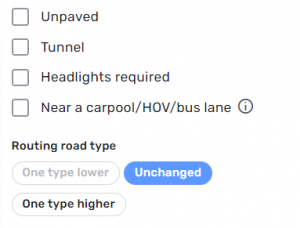
- Unpaved - Select for unpaved segments, see Road types for more information.
- Tunnel - Select for tunnels if the segment meets the guidelines.
- Headlights required - Select for segments with headlight use requirements (Rank 4 required).
- Near a carpool/HOV/bus lane - Select for non-restricted lanes adjacent to HOV or carpool configured lanes. See Partial restrictions for more information on HOV or carpool lanes.
- Routing Road Type - Choices of -1, Neutral, +1 (Rank 4 required). Raises or lowers the road type used in the routing server calculations. Only applicable to Local Street , Primary Street , Minor Highway , Major Highway , and Freeway . Local Street can only be raised (+1) since already the lowest priority of the main routable road types. Similarly Freeway can only be lowered (-1) since already the highest priority of the main routable road types. Note Freeway is automatically given +1 routing preference by WME after a segment is saved; but it has no effect since Freeway is already the highest priority. Selecting this attribute locks the segment(s) for some editing attributes unless the editor is R4+. Should only be used with concurrence of the State Managers. A map comment is recommended to explain why this setting has been changed.
Road direction

The direction of the road is changed by selecting the appropriate direction from the drop down box.
If traffic may travel both ways on the road, select "Two way." If traffic may travel only one-way on the road in the direction from the ![]() toward the
toward the ![]() select "One way (A→B)." If traffic may travel only one-way on the road in the direction from the
select "One way (A→B)." If traffic may travel only one-way on the road in the direction from the ![]() toward the
toward the ![]() select "One way (B→A)."
select "One way (B→A)."
After the road properties are saved, the direction is indicated by black arrows on the road.

Base mapped roads are originally assigned the direction of unknown. When the direction is set to "Unknown", Waze automatically adjusts the directionality of the road as Wazers drive it. When editing, make every effort to determine the correct direction of the road and choose either "Two-way" or the appropriate "One-way" direction.
See the article determining one-way streets for more information on determining the direction of a road as being one way or two way.
Speed limit
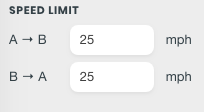
The speed limit fields are shown for the segment. These fields should be updated with the official speed limit as shown on speed limit signs. The speed limit is shown in either km (Km/h) or miles (mp/h), depending on which unit type is selected in the settings tab.

In some locations Waze has run a program to predict speed limits and assign the assumption to segments. When a segment has an assumed speed limit, the limit will be ignored by the app until an editor verifies it. WME displays a Verified check box next to the speed limit field. If you can verify that the speed limit shown is correct, check the Verified box. If you find it to be incorrect, replace the Waze-supplied speed limit with the correct speed limit (there is no need to check the Verified box). Either way, once you save, WME will stop displaying the Verified check box, since it is only needed until verified or corrected.
| Pay attention to the units type displayed next to the speed input field (mph/kph) and be sure to adjust your settings if needed to enter the correct speed.
NOTE: The "Verified" check box will not display when multiple segments are selected, even if they have unverified speed limits. |
- For more details on speed limits policies and how to enter them, see the Speed limits article.
Road elevation

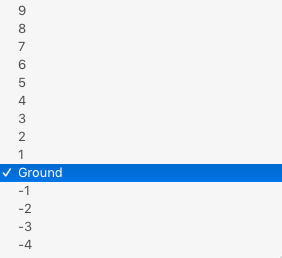
The Road Elevation should be changed where one road passes over another. By default, the Elevation of a segment is Ground (zero). When two segments overlap but do not actually connect in the real world, the value of Elevation for each segment must be different. This ensures that the Waze problem detection system doesn't flag the spot where two segments overlap as a location where a junction might be needed.
The visual representation of the relative Road Elevation is different when viewed in the Waze Map Editor (WME) and the Client application.
1. The Client App displays segment elevation based on the road type only, meaning Freeways are always on top, Major Highways are next, followed by Minor Highways, Ramps next, Primary Streets below all those, and finally Streets are at the bottom. This is the same order seen when setting the road type in the editor.
2. The WME uses the Road Elevation setting to display the relative elevation of the road. It displays the road with the highest "elevation" number at the top of the visual stack and works its way down as would be expected.
Although the client application does not benefit from the Road Elevation setting, it is recommended to set the Road Elevation relative to the physical mapping in the real world to enable possible future Client application updates to show the same visual representation as the WME.
3. Elevation -5 is used for non-drivable roads to help ensure that the routing engine does not try to connect or route drivers from roads onto non-roads by mistake. It acts to prevent false system reporting that the roads should be connected.
See Bridges for more information on elevation.
Road lock

The road lock menu displays locking levels available to each individual user. In the example to the right, the level 4 editor can assign a lock level of 1, 2, 3, or 4. Once the lock level is saved, an editor of a lower level will not be able to make changes to the segment.
See Locking segments for more information.
House numbers

The house numbers is used to create and edit house numbers for named road segments.
See House numbers for more information.
Changing turn restrictions
Each intersection of two or more segments keeps track of the allowed directions you can turn from one segment to another. Changing these turn restrictions follows the same procedure as outlined above in the section on Set allowed turns.

